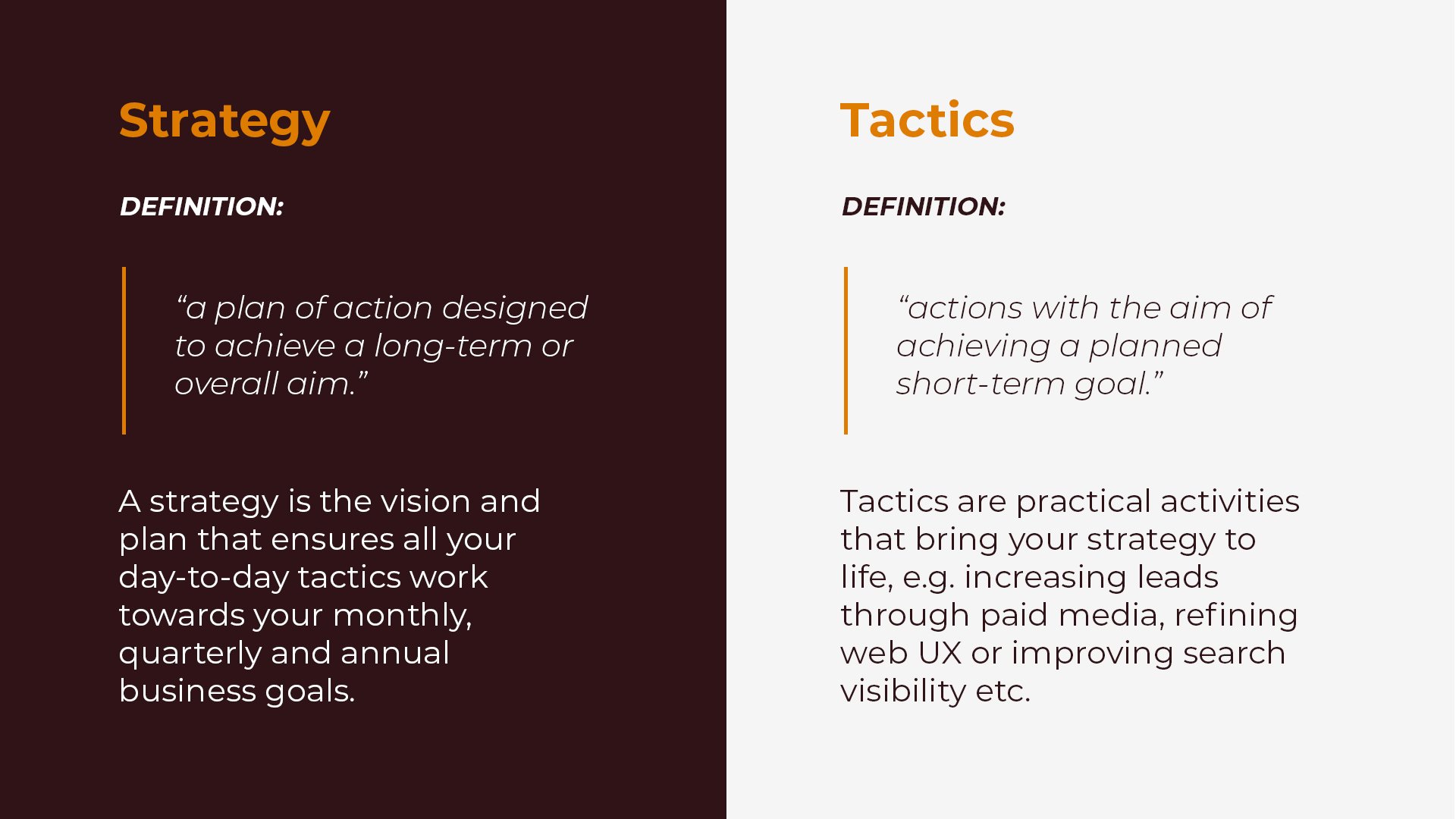So, you’ve been tasked to deliver a new strategy that will ensure your organisation achieves its ambitious growth targets… You organise that workshop, dust off the flip chart, break out the coloured pens and cue the inevitable buzzword bingo that will ensue.
It’s becoming a regular feature for brands and agencies alike to spend several hours in a room to formulate new ideas to steal a march from competitors. Lots of people talk about ‘strategy’, but I wonder how often it gets confused with ‘tactics’. Sadly, this misunderstanding is far too common amongst marketers, PRs and – perhaps more importantly – clients, who never really question it.
At StrategiQ, we advocate dedicating serious time with clients to unearth the fundamental drivers and objectives that will inform and enhance all aspects of their marketing activity. In the process, we’re often asked about the difference between ‘Strategy’ and ‘Tactics’.
Actually, the distinction is quite simple. But, to be successful in your marketing, it’s vital to understand exactly what they both are, the differences between them and how they work together.
So, what is the difference between Strategy and Tactics?
They are quite distinct, but one will not work properly without the other:
All strategy and no tactics means you have an idea of what you need to do, but don’t take the required steps to get closer to your goals or gain traction in a competitive marketplace.
At the same time, short-term tactics without an end game in mind is not a strategy. Tactics work best only when used as part of an overall strategy, informed by audience insights.
How do they get confused?
Marketers and business owners will often identify an objective (e.g: ‘get more quality leads’) and jump straight to an action or tactic that they think will get the result they want (e.g.: ‘let’s write an informative blog post and promote it on socials’). This is a classic case of labelling a tactic as a strategy.
The key realisation here is that you need a strategy to sit between the objective and the tactics. A strategy is the plan to achieve your objective. And the tactics will support the strategy.
In the above example, to get more leads, your strategy would identify exactly who those people are, which channel they will be most likely to engage with, and then the key information they need to see to make a decision. Then you can craft your tactics to suit – creating your blog and social posts with that exact audience and message in mind.
It might be that in the process of creating your strategy, you realise that different tactics might actually be more effective (perhaps the audience will respond better to Google Display Network ads rather than a blog post). This is a good thing! It’s exactly why the strategy process is so important, and why we take pains to get it right.
Objectives first, then strategy, then channels…
It’s impossible to create marketing strategies before defining your objectives. Marketers who set objectives are far more likely to achieve success than those who don’t.
Marketing objectives should be actionable targets designed to drive the overall success of your company – real targets that you know you can achieve in line with your data and available resources – not just an arbitrary number that sounds good. They should be specific, measurable, attainable, relevant and time-based (often referred to as SMART goals, an acronym you’ve likely heard before!).
For example, a marketing goal might be to increase website traffic by 50%. But how will you get there? And why? What will be the purpose of that traffic, or the impact that endpoint will have on the company as a whole? And when do you want to hit that number?
You have to look at specifics, rather than a vague idea that feels right. For example, you might say: ‘I will increase our revenue by 20% within six months (goal) by growing website traffic by 50% this quarter (objective), targeting a predetermined audience with a specific offer (strategy), using case studies promoted via social media (tactics).
Before going any further, ask yourself: where are you right now with your vision for your business? Should you be thinking about tactics yet, or outlining a strategy? Or, in fact, figuring out what your business and marketing objectives are first?
Strategy Defines Success
On a most basic level: strategy is big, tactics are small. Strategy is long term; tactics are short term. Strategy is the plan; tactics is the action. But together, they need to work in line with your business objectives.
It’s useful to look at this through real-life examples of the strategies we defined for clients and the tactics we used to achieve:
Client: Jacada Travel
Objective: Increase inbound leads by 100% following the Covid pandemic
Strategy: Connect with higher net worth prospects who show an interest in global travel. Generate deals for the sales team to progress through the customer journey and secure high value bookings.
Tactics: Targeted ad campaigns across the paid media landscape, SEO & email. UX & CRO through the website to improve conversion.
or
Client: Factory Direct Flooring
Objective: Exceed previous annual turnover and grow brand visibility
Strategy: Ecommerce revenue growth of 15% over 12 months whilst maintaining 300 ROAS for campaigns.
Tactics: SEO to improve core web vitals, mitigate cannibalisation and refine search footprint and keyword focus. Paid social ads to broaden campaigns to inmarket users, in addition to refining remarketing audiences and introducing video ads.
Strategies tend to be consistent, while tactics are evaluated and changed more regularly as consumer behaviour and new technology comes into play.
So what now?
Essentially, businesses should avoid sticking to the same old tactics and need to think more about their strategy. Most importantly, does your business have the time, resources and budget required to fulfil the analysis and core marketing assets you need to compete both on and offline?
Strategy is about lifting ourselves out of the everyday ‘thinking’ and ‘doing’, and taking a step back to look at things from a wider or external perspective. This is simple to say, but often not easy to do. If you’re planning marketing strategy or tactics for your company, speak to someone who’s curious enough to ask the right questions to get you thinking about the big picture.
If that’s you… get in touch today!

